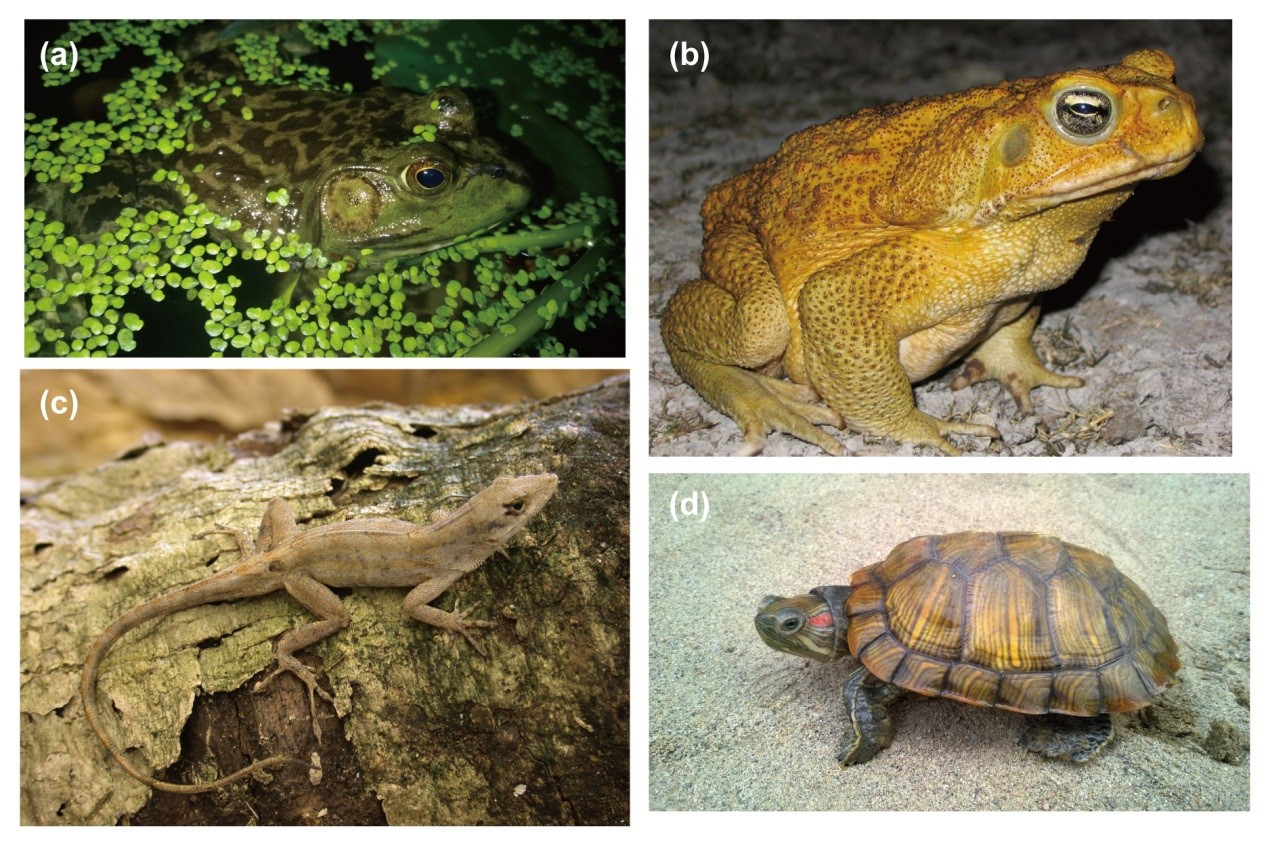Biological invasions are a major threat to global biodiversity and ecosystem functioning. Understanding where invasion hotspots are located and how they overlap with biodiversity hotspots is crucial for prioritizing conservation efforts to prevent or mitigate impacts from alien species on global biodiversity.
Using an ensemble of five species-distribution models (GLMs, MARS, BRT, RF, and MAXENT) based on climate, anthropogenic predictors, vegetation and water resources, the Diversity and Spatial Ecology Research Group led by Prof. Yiming Li predicts global potential invasion hotspots (e.g., environmental conditions suitable for numerous alien species) for alien herpetofauna (reptiles and amphibians; 98 amphibian species, 181 reptiles species) under current and projected climates (2050s and 2080s). Alien herpetofauna include a number of the most notorious globally invasive species, such as the American bullfrog (Lithobates catesbeianus), Cane toad (Rhinella marina), Brown anole (Anolis sagrei), and Red-eared slider (Trachemys scripta elegans) (Fig.1). They can have serious ecological, evolutionary and societal impacts in their invaded ranges. Models show that under current climate the areas liable to invasion by the greatest number of alien herpetofauna occur in western Africa, South and Southeast Asia, Caribbean, eastern South America, Mediterranean region, and eastern Madagascar (Fig. 2). Under future climates, these hotspots will expand toward the north of South America, into central Africa, and toward high latitude areas of Europe, where newly suitable environmental conditions will be created. In contrast, some areas, such as western South America, the countries bordering the Red Sea, and northern and southern Africa may become less susceptible to invasion. Herpetofaunal invasion hotspots concentrate in biodiversity hotspots. The potential richness of alien herpetofaunal species per unit area in biodiversity hotspots is 1.4 higher than those in other regions. Furthermore, the invasion hotspots are projected to occupy a large proportion of total area within biodiversity hotspots. These results suggest that biodiversity hotspots are more at risk from alien herpetofaunal invasions than are other regions. Their results provide key information for globally targeting early detection and rapid-response programs to reduce the negative effects of alien herpetofauna on biodiversity under current and projected future climates.
This paper has been published in Frontiers in Ecology and the Environment (http://onlinelibrary.wiley.com/doi/10.1002/fee.1321/full). Dr. Xianping Li and Dr. Xuan Liu are the first coauthors, and Prof. Yiming Li is the correspondence author. The project is supported by a grant from the National Science Foundation of China (code: 31530088) and a grant from the Ministry of Science and Technology of China (code: 2013FY110300).

Fig. 1. Four species of invasive herpetofauna. (a) American bullfrog (Lithobates catesbeianus) is responsible for spreading the chytrid fungus that has caused amphibian population declines and is a predator and competitor of many small vertebrates; (b) Cane toad (Rhinella marina) has poisoned native predators in Australia; (c) Brown anole (Anolis sagrei) outcompetes and consumes native lizards; and (d) Red-eared sliders (Trachemys scripta) hybridize with and compete with native turtles.

Fig.2. Overlap between biodiversity hotspots and predicted alien herpetofaunal invasion hotspots, and their changes over time under RCP 2.6. (a) overlap under current climate; (b) overlap by 2050s; (c) overlap by 2080s; (d) dynamic overlap changes over time. Alien-species hotspots are defined as the top 25% of all the cells with the highest species richness. In panels a, b and c, green areas indicate biodiversity hotspots only, orange areas indicate predicted invasion hotspots only, and red areas indicate regions shared by both. There are seven colors in panel d, the largest areas (in purple) indicate consistent areas of the regions shared by biodiversity hotspots and predicted invasion hotspots in different periods between current, 2050s, and 2080s climates, see Color legend for details.


